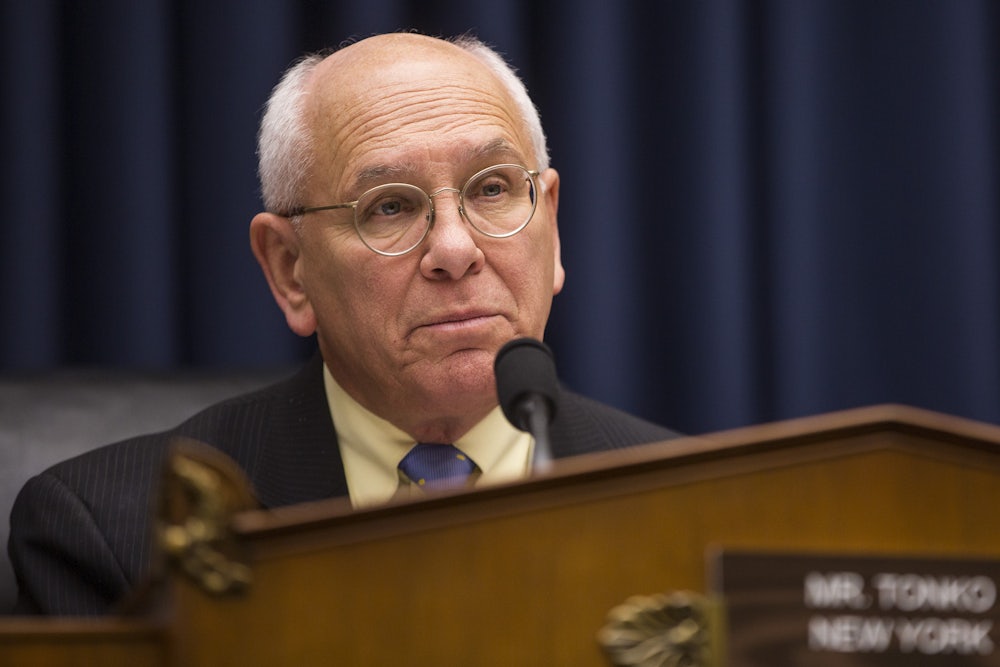On Tuesday afternoon, the top three Democratic members of the House Energy Committee unveiled what they called a “bold new initiative” to tackle the climate crisis. Meant as a more moderate alternative to Congresswoman Alexandria Ocasio-Cortez’s Green New Deal—which calls for a carbon-free economy by 2030—the new plan calls for the United States to reach net-zero greenhouse gas emissions by 2050. It’s called the “100 by ’50” plan.
The Democrats’ new plan comes days after an oppressive heatwave covered much of the United States in 100-plus-degree temperatures, affecting 150 million people and killing six. It also comes a week after Tropical Storm Barry inundated the already-flooded Mississippi river, overtopping three river levees and causing devastating flooding in four states.
But the timing is perhaps all the plan gets right, because its ultimate goal of net-zero emissions by 2050 is neither bold nor new. Instead, it represents the very edge of what most climate scientists say is necessary to prevent catastrophic warming of the planet. And overall, the so-called plan illustrates the kind of rhetoric-without-action that has come to typify much of the Democratic mainstream’s approach to climate change in the era of Donald Trump.
Many environmental groups praised “100 by ’50.” The National Resources Defense Council said House Democrats “are setting bold goals to protect our children and grandchildren from climate catastrophe”; and the Sierra Club said in a statement that House Democrats are “taking the 100 percent clean energy progress happening in cities and states all across the country to a national scale.”
But in terms of an actual plan, there’s little to be seen. Like the Green New Deal, the “100 by ’50” plan is not legislation; the House Democrats who called Tuesday’s press conference did not do so to introduce a bill. Instead, Energy Committee Chairman Frank Pallone announced that the committee would be “starting a process” toward legislation, with the ultimate goal of releasing a climate bill sometime before the end of 2019. That process, he said, would include a series of hearings and meetings with stakeholders once Congress returned to Washington in September, following the upcoming August recess. (Tuesday’s initiative is different than the 100 by ’50 Act, a 2017 Senate bill that sought 100 percent renewable energy by 2050 through the use of carbon fees, increased carbon regulation, and renewable energy tax credits, among other things.)
The Democratic lawmakers who announced the “100 by ’50” plan say they understand the urgency of the climate crisis. “The cost of inaction is expensive,” said Congressman Paul Tonko, who chairs the Energy Committee’s environment subcommittee. “We cannot afford another minute of delay.” But Tuesday’s announcement was a plan to make a plan to eventually make a plan to fight the climate crisis. It was, in essence, another form of delay.
It’s a troubling delay, considering how quickly scientists say action is necessary. To prevent the world from warming more than 1.5 degrees Celsius—the point at which catastrophic, irreversible damages begin—global carbon emissions need to be halved by 2030, and reach net zero by 2050. In other words, Democrats are proposing to wait until the last possible moment to achieve net-zero emissions.
So while the Democrats’ new initiative is technically in line with what the science says needs to be done to avoid the worst impacts of global warming, it is hardly a bold initiative that could lead the world to rapidly decarbonize. Instead, it’s like waiting until eight-fifty-nine in the evening to get your car out of a parking garage that closes at nine o’clock—technically feasible, but only possible if all the other cars in front of you have left the garage, too.
That’s why the Green New Deal proposes net-zero carbon emissions by 2030: to give other countries time to use the United States as a model. And the United States has a responsibility to be that model, because the United States has emitted more greenhouse gases than any other country in the world, and has reaped substantial economic benefits from those emissions.
The Green New Deal may have a more scientifically and morally appropriate goal than the “100 by ’50” initiative. But at this point, neither are actual plans that provide any kind of functional roadmap for climate action. Indeed, eight months after taking back the House and nearly three years into the Trump presidency, Democrats across the ideological spectrum have failed to introduce comprehensive legislation to tackle the climate crisis. They’ve instead spent months reviving old committees, and producing what Tonko called “a framework of principles” to guide any future climate plan.
While process is important—particularly for a crisis as sweeping as climate change—the Democrats’ lack of concrete, comprehensive solutions stands in sharp contrast to their professed understanding of the immediacy of the threat. Releasing a plan to make a plan is fine; releasing an actual plan would be better, and Democrats have had both the time and support from their base to make that happen.
